Xihu - the Causeway and the Boat Ride
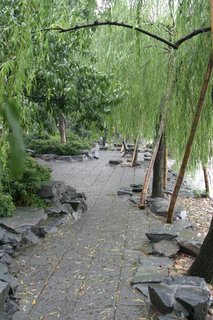 Following the stop at the hotel, we drove around the lake to the start of one of the several causeways that cross the water. Most of the tourism starts here. There are multiple gardens, several older villas and the launching area for the boat tours. As you can see, we've finally made it a small way into traditional China. The landscaping and associated architecture were simply beautiful, and for once we were beginning to feel like the rain was actually an enhancement instead of a problem. The unloading area was busy with many other tours, all led by young women whom I imagine are studying tourism at university just like Lili is. Each had a small electronic microphone and a colored flag that they waved to keep their herd intact and moving forward. Lili kept hers in a plastic bag, figuring we were far to cool to have a flag waved at us.
Following the stop at the hotel, we drove around the lake to the start of one of the several causeways that cross the water. Most of the tourism starts here. There are multiple gardens, several older villas and the launching area for the boat tours. As you can see, we've finally made it a small way into traditional China. The landscaping and associated architecture were simply beautiful, and for once we were beginning to feel like the rain was actually an enhancement instead of a problem. The unloading area was busy with many other tours, all led by young women whom I imagine are studying tourism at university just like Lili is. Each had a small electronic microphone and a colored flag that they waved to keep their herd intact and moving forward. Lili kept hers in a plastic bag, figuring we were far to cool to have a flag waved at us.It's clear that the Chinese government is cognizant of their incredible asset - culture, beauty and a means to provide it to willing tourists, most of whom were from other areas of China. We saw a total of 3 other westerners here during the 2 or 3 hours we spent wandering around.
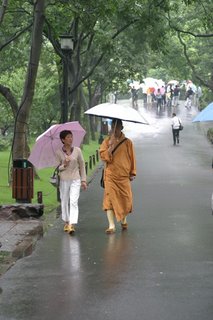
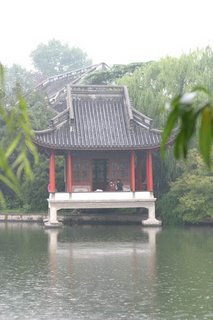 Several of these shots were taken on the grounds of a beautiful villa, now a small museum. It belonged to a local governor who led the fight against the Japanese during WWII. His gardens were beautiful and very peaceful.
Several of these shots were taken on the grounds of a beautiful villa, now a small museum. It belonged to a local governor who led the fight against the Japanese during WWII. His gardens were beautiful and very peaceful. The building is a two storey white plaster affair with the largest Magnolia tree I've ever seen - perhaps 30' tall. I thought these walls were intersting for the windows and doors they contain.
The building is a two storey white plaster affair with the largest Magnolia tree I've ever seen - perhaps 30' tall. I thought these walls were intersting for the windows and doors they contain.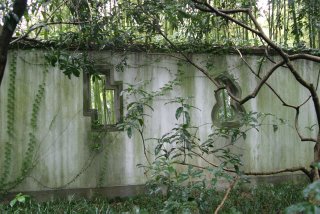
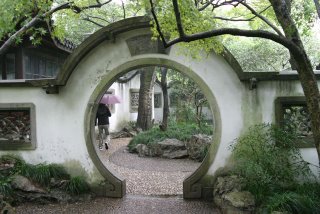

This fish pond has a story of its own. It's very ancient, and the tale goes that once there were two famous philosophers visiting and admiring the fish. One said, "These fish must be very happy in such a beautiful place." To wit the other replied, "How can you say that you now that, when you are not a fish?" Thinking for a moment, the first philosopher said, "How can you know what I know, when you are not me?"

This is a shot of one of the tour boats, of which there are around 2 dozen. They pick up the tourists, motor off to one end of the lack, turn around and come back. It's a nice little ride, but there is much about it that's a bit odd.
We arrived towards the end of the loading period and there were no more seats on the boat. Being a non-confrontational American, I offered that we should wait for another one but Lili took charge. She spoke a few words to the captain who in turn went back into the cabin and started yelling at the other passengers. He was demanding that they crowd together in order to make room for us. Grudgingly, they did so, which made me feel pretty bad. But, off we went.
The ride itself was pretty non-descript but pleasant. We passed many smaller private launches, propelled and steered by a single oar out the stern. We also saw the second major temple in the area, "The Thin Lady." In local lore, Xihu is a woman, and the tall thin temple represents her youth, when she is young and lithe. The other temple, short and squat represents her middle age, when she's put a few pounds on. The main causeway, which is lined with Peach and Betel trees is her belt, which is pink and white when the tree blossom in
 the springtime. An interesting thing to note about the trip was the general ennui of our boat mates. Mostly, they were sitting in the cabin, staring inwards and ignoring the sites outside. Not many looked as though they were the least bit interested in the tour. Perhaps not any different than tourists everywhere.
the springtime. An interesting thing to note about the trip was the general ennui of our boat mates. Mostly, they were sitting in the cabin, staring inwards and ignoring the sites outside. Not many looked as though they were the least bit interested in the tour. Perhaps not any different than tourists everywhere.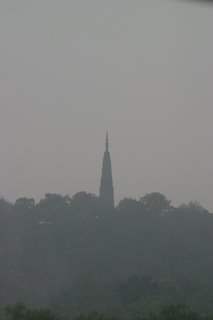
There is another local legend about the Snake Lady and the Philosopher. They were lovers, who were finally broken apart by an evil monk. The met on the Broken Bridge, which is the final bridge on the causeway. Interestingly, it's not broken, as evidenced by the people crossing it. Lili's explanation was that in the winter, when covered with snow, it appears white. Because of the angle of the sun, the snow melts on one side and not the other which in turn gives the bridge the appearance of being broken. But in reality, it is called so because of the broken heart of the Philosopher. The evil monk, gave rice wine to the Snake Lady which made her appear as a snake. He then captured her and buried her under the 15 layers of clay at the bottom of the lake. So sad.

This final picture is of one of the Three Pagodas. They are simultaneously small temples and markers for the deepest part of the lake. During the Lunar Festival, candles are placed inside each of them. Each has 5 holes, and the light shines out both sides, giving the number 10. There are three of them, bringing the number to 30. The Moon above makes 31, its reflection 32 and the Moon Cakes which are eaten during the festival make the total 33. The significance of which I have no clue whatsoever.



Comments